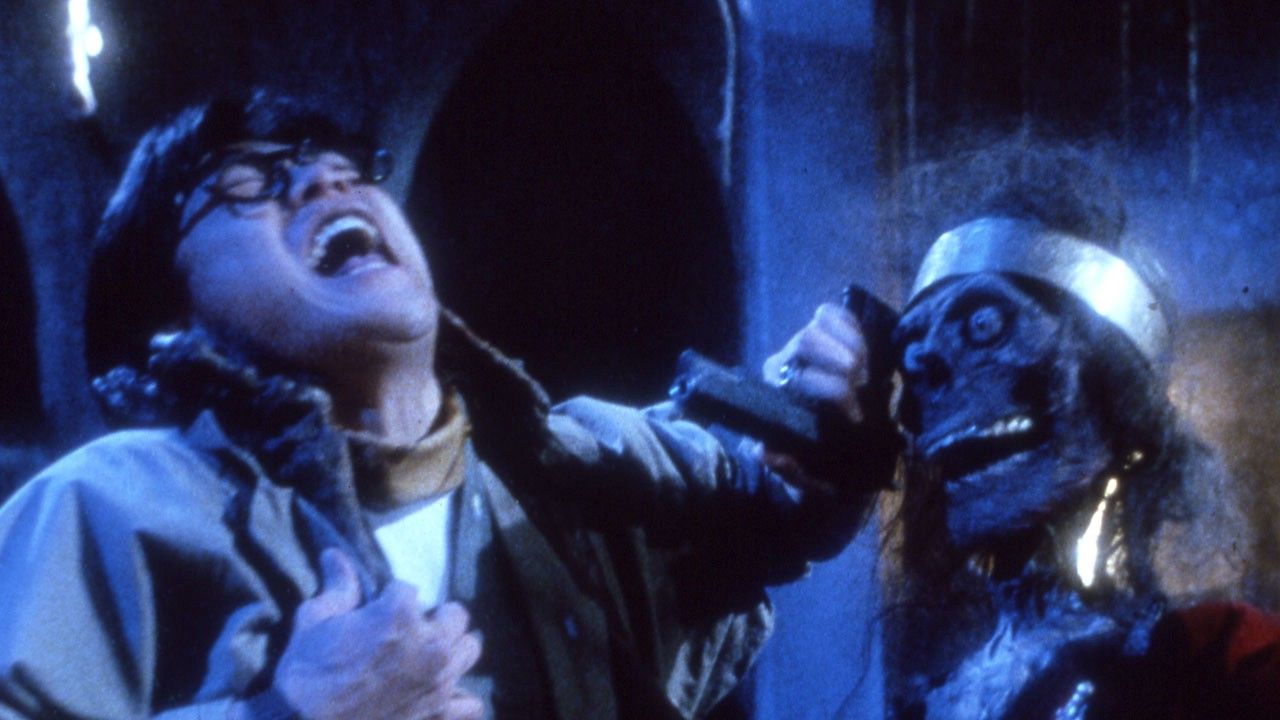The Seventh Curse (Lam Nai-choi, 1986)

Maybe the most 1980s Hong Kong movie ever made. Part of the “Don’t Go To Thailand” horror tradition, wherein an urbane Hong Konger travels to the jungle, does something stupid, and ends up with a horrible magic curse that manifests itself in increasingly gory special effects. This generic cycle peaked with Kuei Chih-hung’s Bewitched and The Boxer’s Omen in 1983, and The Seventh Curse seems explicitly designed as an homage to those earlier films. Of course, given the lightning speed of Hong Kong generic cycles, they were made just three years earlier. The film opens with a frame story, as legendary Shaw Brothers screenwriter Ni Kuang (he has 221 credits on the hkmdb, from Chang Cheh’s The One-Armed Swordsman in 1967 to Lau Kar-leung’s 8 Diagram Pole Fighter in 1984, but this was his first on-screen appearance) hosting a swanky dinner party surrounded by Miss Hong Kong contestants. He asks his friends, Chow Yun-fat’s Wisely and Chin Siu-ho’s Yuan Chen, to tell us a story of their adventures, and so the movie unfolds.
Yuan some time ago travelled to a remote village in Thailand, where he rescued a beautiful woman from an evil sorcerer’s human sacrifice. In retribution, he was afflicted with a blood curse. The woman rescued him by cutting a healing worm out of her breast, but it turns out the cure only lasted for one year. Yuan has to go back to Thailand to find a more permanent cure, and also rescue the woman, her boyfriend (Dick Wei), and their village. Tagging along are Rainbow (Maggie Cheung), a plucky girl reporter, and, eventually, Chow Yun-fat and Sibelle Hu, who appear to have been available for only a few days of shooting. What follows is 78 minutes of non-stop action (choreographed by Yuen Bun), gore, and bizarre verbal comedy cobbled together by none other than writer Wong Jing (in collaboration with Yuen Kai-chi) and director Lam Nai-choi.
The Wisely character features in over 150 stories and novels written by Ni Kuang from the early 60s up until 2004, traveling the globe and freely mixing science fiction, fantasy, and mystery fiction traditions. This was the first Hong Kong film adaptation of a Wisely story (though technically it’s a Dr. Yuen story, another series of novels Ni Kuang wrote in which, like this film, Wisely is a supporting character), others include Tsui Siu-ming’s Bury Me High, in which the character is played by Chin Siu-ho’s younger brother, Chin Kar-lok, and The Cat, Lam Nai-choi’s final film, in which the character is played by Waise Lee.
The Seventh Curse is a movie that couldn’t have ever been made at any other time or any other place than Hong Kong in the 1980s: practical effects that look like homemade knockoffs of John Carpenter products, but are horrifying and gross nonetheless and eerie deep blue nights and bright pink fires, with bursts of cheap green electricity standing in for magical powers. But most unique is that the fundamental weirdness of it all rests within sturdily familiar adventure story structure. It’s not Lucio Fulci’s Conquest, wildly reinventing the movie quest narrative in service of truly unhinged gore. It’s as classical a serial as the Indiana Jones films; King Kong but with a tribe controlled by evil worm magic instead of a giant ape with an affinity for blondes. It’s that combination of the strange and the familiar, more than simple exoticism or the trashy joys of bad subtitling, that makes The Seventh Curse more than just a cult classic. It embodies that sense of freedom, the wild energy of just (seemingly if not actually) making it up as you go along, of putting anything into a movie as long as it elicits a reaction (laughter, disgust, awe, fright, befuddlement, excitement, etc) that so distinguishes Hong Kong film between the collapse of Shaw Brothers and the imposition of the Handover. It’s well-crafted cinema of great skill that feels like it was made not just without but in defiance of every rule.
